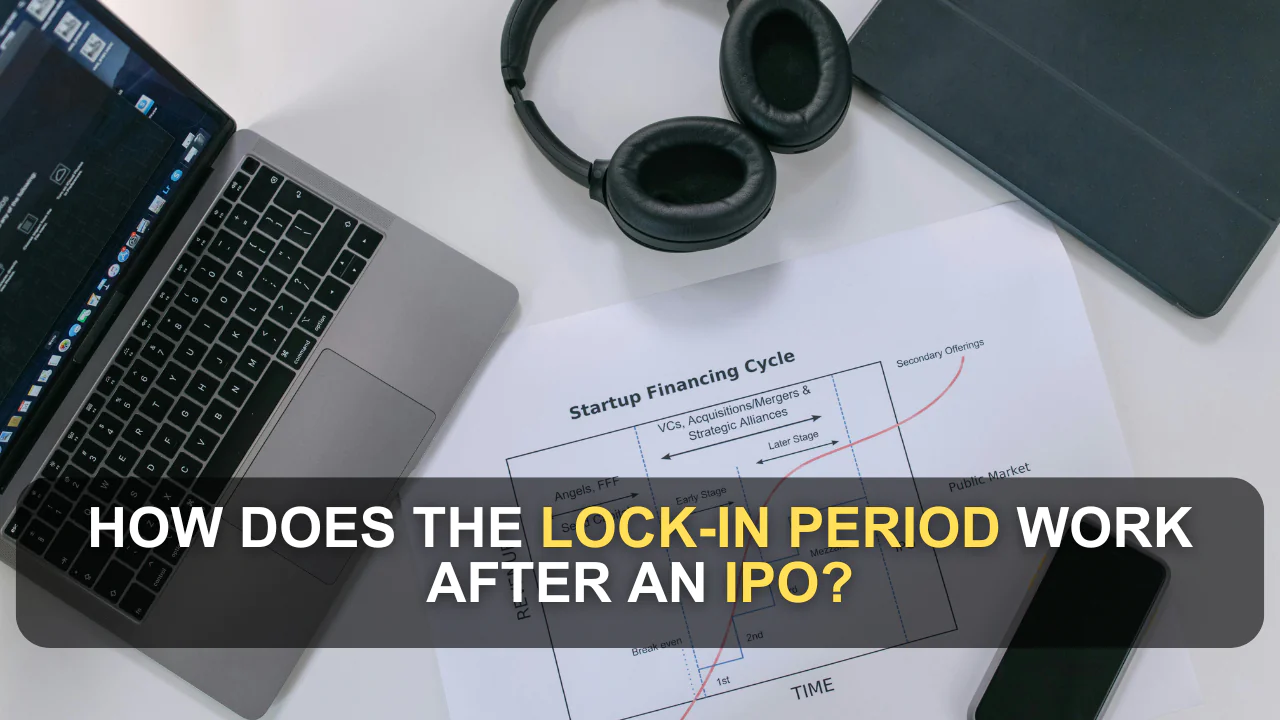When companies decide to float their shares they do this through an Initial Public Offering (IPO) and one thing that is most times looked at is the lock-in period. It is an important term to investors and insiders as it defines the times when particular shareholders can sell their stock. This fact can be of importance for those who decide to participate in an IPO because the lock-in period’s structure defines the company’s development.
In this article, let us explain what the lock-in period means, why it exists, and how it affects people, and shares of stocks as well as stock prices.
Table of Contents
What is the Lock-In Period?
The lock-in period is defined as a specified period within which some of the shareholders; particularly those on the inside are prevented from selling their shares after offering their stocks to the public in what is referred to as an IPO. These shareholders can be the company executives, the founder, employees, and early investors such as venture capitalists. The rationale for the prohibition of public float for an IPO company is a desire to stabilize the stock after listing as well as a constraint against making a large number of shares available to the public too early.
The lock-in period usually lasts from 90 to 180 days, but this time may be changed according to the terms of cooperation between the company and underwriters. The lock-in period details are normally provided for in the IPO prospectus approved by the exchange.
What Is the Purpose of the Lock-In Period?
The lock-in period is mainly aimed at shielding the newly public company and the investors from the brunt of an impending IPO by locking in significant stocks that cannot be sold for a given period. The lack of a lock-in period means insiders holding large numbers of shares can liquidate their stakes as soon as the firm’s stock goes public thus depressing the value of the stock. It could repel greenfield investors and make the market volatile.
Additionally, the lock-in period:
Builds trust with new investors: It makes the market understand better that insiders are in it for the long-term and not just to ‘rip off’ the new IPO.
- Prevents volatility: Sometimes situations force large shareholders to sell their stakes in a company immediately after they go public, which causes the price of the stock to go up or down independently of market forces, and begins the process of controlling the supply of the floated stock.
- Encourages long-term value: Employees are more likely to be more preoccupied with the growth of the company if they have to hold the stocks for at least a prescribed number of years.
Who stands to be affected by the lock-in period?
From this, it can be deduced that the lock-in period does not apply to all shareholders of the business. It primarily affects:
- Company insiders: These include the chief executive officer, members of the board of directors, and the executive management who often own a large number of shares in the business. Such individuals are regarded as being in a position to possess information regarding the performance of the company hence restricting their ability to dispose of their stocks prevents them from realizing short-term gains.
- Early investors and venture capitalists: Early investors which may include Venture capital firms are normally restricted under the lock-in period after the company uploads an IPO. These stakeholders normally possess a big percentage stake in the company, and their decision to disinvest may cause a shift in the supply side.
- Employees with stock options: Performance shares are other common forms of shares that form part of the packages that most employees receive from their employers. Such employees are denied the liberty of exercising their share lock-in period soon after the IPO is underway.
Institutional investors who buy shares during the IPO or after the issuance on public markets are not restricted from selling their shares within the lock-in period therefore they are free to sell their shares.
What Are the Consequences of the Lock-In Period on Stock Prices?
The particular phase that often receives close attention is the lock-in period phase since its expiration usually exerts a great influence on the stock prices of many business firms and investors. At the end of the lock-in period, insiders can start selling their stocks, and this results in a massive offer on the market. This proposal suggests that if a large percentage of the shares is sold, the market value of the shares is likely to reduce because there will be more competitors in the market.
However, the actual impact on the stock price depends on several factors:
- Company performance: If the firm has been on a growth spree after the IPO then the insiders will be more inclined to retain the share while avoiding situations that lead to a drop in prices.
- Market conditions: These conditions ensured that the additional shares find ready market without necessarily putting a lot of pressure on the price per stock.
- Investor sentiment: Investors who expect the growth of the company’s stock value over the long run may not want to sell their shares when the lock-in period ends, instead, they may want to purchase more shares.
At other times, the stock price may remain virtually unchanged throughout such shocks due to firm fundamentals and sustained, investor confidence besides other factors.
Lock-In Period Agreement: What Happens When the Lock-In Period Expires?
After the lock-in period elapses, they can dispose of their shares in the market for insiders and other restricted shareholders. It equally forwards or negates the evaluations of the company’s stock price and performance on the market.
Potential for a Sell-Off
Particularly, after the lock-in period is over, some insiders may sell these equities to realize their gains. The other risk of holding many shares is if they are sold, many at a go, it puts pressure on the market price hence lowering the value per share in the short run. New investors may also be worried after this sell-off, because a cut in the price may be associated with a lack of confidence by insiders.
Nevertheless, lock-in periods do not always trigger a sell-off. Often they may have their visions of the future development of the firm and decide to remain shareholders. Besides, if since the IPO the business has posted good results, then supply may be easily met by demand without a decline in the share value.
Market Volatility
Most of the time it is observed that once the ock-in period is over, high volatility gets reflected in the stock exchange. If insiders and first-round shareholders become free to trade their stocks, the supply and demand fluctuations within the market could cause short-term stock volatility.
However, such movements are expected by advanced investors and are usually taken into consideration when developing further action plans. While others could consider such lock-in expiration, as a chance to purchase shares at a cheaper price in case the stock price falls for some reason. Some may be hesitant and would opt to sit back watching as other players in the market make their moves.
Media and Analyst Attention
The lifting of a lock-in usually triggers information searches from the media and market analysts who may want to know how the whole event turns out especially as it affects stock. They stated that this may increase the focus on adjustments made by these companies, which in turn affects the mood of the investor and adds pressure to the market. For example, if there is for example an expectation that there will be a heavy sell-off, this perception alone may put pressure on the stock and may occasion negative sentiment even before the expiration of the lock-in period.
About Lock-In Periods: New Investor’s Guide
Therefore, to assist retail investors in making proper decisions, the main implication of the lock-in period has been highlighted. Here are some tactics to think about:
- Monitor insider activity: Focus on the activities of the management before and after the lock-in period. When the CEOs or the large shareholders begin to offload huge portions of the company’s stock, the chances are high that they have lost confidence in the firm’s future performance.
- Look for long-term potential: Thus, though the changes in the price might be influenced by the expiration of the lock-in period for the company, one has to concentrate on the issue of the company’s fundamentals. If the company has all the right ingredients for it to grow, low stock prices could be a good opportunity to buy the stock.
Be mindful of market timing: Some investors may wish to purchase shares after the lock-in period has ended in order not to become victims of buying stocks at their all-time high before a selling spree. However, if you have confidence in the company and its prospects, this may not be relevant as you should hang on to your stock for the long term.
Lock-in Period in Different Markets Victims Final Report
Lock-in periods exist in all world markets and depend on certain rules and requirements of each country. In the United States for instance the standard lock–in period extends for 180 days, as per the guidelines provided by the Securities and Exchange Commission (SEC). In India, SEBI has prescribed one ya lock-in period for promoters and a similar restriction of 90 days for certain other categories of shareholders.
To have a clear view of the possible impacts of the lock-in period regulations it is wise to investigate the laws of the market that is of interest to you in detail.
Conclusion
The lock-in period is a relative concept within the framework of IPO and is considered rather important for stability in the stock markets and for the interests of both the company and investors. Although it checks those insiders who want to sell their shares right after the IPO has happened, it also has its part to play in protecting investor confidence and avoiding unnecessary fluctuations in the share prices.
Ending towards the duration of the lock-in period, the market shows signs of increased performance and unpredictable prices. But by paying attention to company fundamentals and insider activity one can successfully invest and avoid this period.
Indeed, irrespective of the kind of investor you are – a new one or an experienced trader, it is profound knowledge of how this lock-in period impacts the stock prices to guide your investment decisions after the IPO.
This way, anyone who is aware of the lock-in period can predict the volatility of the market, take the optimal buying chance, and have control over their portfolios.




